Roger Hepworth describes the scene as travellers gathered for their... Excursion to Scarborough
Roger Hepworth describes the scene as travellers gathered for their… Excursion to Scarborough
As the short days of a 1950s January turned into February and then March, schoolboy spirits were lifted by the thought that soon the routine comings and goings of our regular passenger, goods and parcels workings would be boosted by the Easter excursions, or “trips” as we all called them. While other youngsters would play with their new whips and tops, purchased in the local shops, or go off collecting frogspawn in old jam jars, we more discerning youths would go down to the mill dam on Easter Sunday for quite another reason: for here, among the early wild flowers and budding hawthorn hedges, was one of the best lineside viewing spots in the area.
The handbills would have been hanging in bundles in the windows of the station booking hall for several weeks. Printed each in a single different bright colour, these sheets of quarto sized newsprint were eagerly collected by us spotters, sometimes to the annoyance of the station staff. We were terrified of one porter in particular who would chase us off the premises with loud shouts that if we took any handbills, “there would be none left for anyone else!”
The trip’s destination was printed boldly right across the sheet near the top, typically Scarborough, Bridlington or that favourite Eastern Region resort, Cleethorpes. This was followed by columns of small print, detailing the times of departure and arrival back and the fares. In those days of twelve pound a week textile wages, a trip generally cost between eight and twelve shillings for adults, with ‘children under fourteen half fare’. The price depended on distance to be travelled and whether it was a Day or a cheaper Half-Day trip. Many families took advantage of these trains which usually left Ossett comfortably full, except for a few compartments at the very front and back of the eight or ten coach sets. Occasionally, stations were served which had already closed to normal traffic, for example, Alverthorpe and Lofthouse & Outwood.
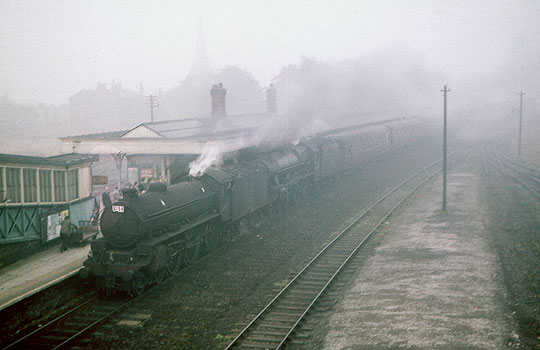
Photo: Roger Hepworth
By this period, our branch line would have to be specially opened for the Sunday trains, no doubt involving some welcome overtime for the station staff and for the friendly signalman in Ossett East box with its wheel operated level crossing gates. On Bank Holiday Mondays, the following Tuesdays and even Wednesdays, the excursions ran interspersed with the normal services.
Usually originating in Bradford and calling typically at Drighlington for Adwalton, Batley and Dewsbury before ‘our’ station, these trains would then either serve Wakefield, or if bound for Bridlington or Scarborough, turn left at the Wrenthorpe triangle towards Leeds, but then shortly branch right at Lofthouse and call at Stanley and Castleford Central.
Except for a few eight-coach race specials to Doncaster, excursions invariably consisted of corridor coaches – usually open stock, immaculately turned out inside and out. Despite obvious efforts to keep the rakes uniform, there were inevitably occasions when the smart maroon livery was broken up by one or more red and cream coaches or when a set turned up where some Gresley bow-ended roofs and angular wooden panelling would contrast with the smooth rounded steel sides of newer BR standards. Inside, the contrasts between old and new were just as striking. The newer coaches seemed very cosy, especially on the return journey at night with their warm brown veneer interior panelling and pleasing dark red upholstery, subtly lit by large circular frosted glass ceiling fixtures and nicely shaded twin-bulb light boxes above each table. Internal handles and other fittings were of aluminium and the toilet compartments neatly finished in lemon coloured Formica.
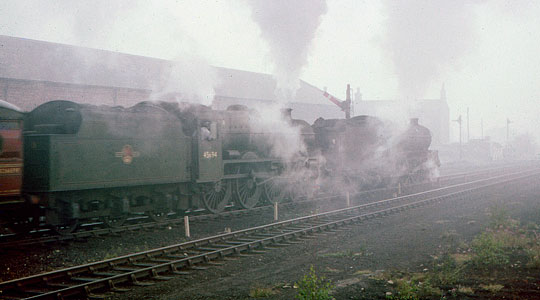
Photo: Roger Hepworth
The older Gresley coaches, although very comfortable with their brown upholstered seats, somehow had a more austere feel to them. The upper interior panels were painted a plain cream which, together with the generous row of high wattage bare tungsten bulbs fixed in a central line all along the white painted ceiling, made them much brighter to travel in at night. This was also very noticeable from outside. Frameless oval mirrors etched with the letters LNER or BR(E) were mounted vertically – often with the lettering on the wrong axis. These were fixed along the side panels above the seats between the windows together with pairs of those hat and coat hooks in the shape of an inverted capital G. These and most other fittings were finished in rather brash 1930s shiny chromium plate. The vestibules were brush grained in light oak and the toilet compartments seemed rather spartan with cream painted walls again and exposed lead waste pipe to the hand basin. This would be provided with the usual pink soap – two or three joined up small tablets, broken off a long bar, each one bearing the moulded-in proprietorial letters BR(E). What else!
This then was the typical excursion stock of the period. Of course, side-corridors were sometimes used – any normally first-class compartments being in great demand. I recall a couple of Sundays when even Southern Maunsell sets called at Ossett. These ten-car rakes caused quite a stir with their green livery and the window glass of some compartments etched with the panel SMOKING in a way quite unknown here in the north. No doubt these coaches were pressed into service having arrived in the north on a Saturday inter-regional service from, say, Bournemouth.
These eight or ten-coach trains had to be hauled up the steep West Riding gradients including the 1:50 between Dewsbury and Ossett. On those still Sundays of the period, the breeze would carry to us, intermittently at first, the strong, lively exhausts of two hard-working engines. As the roar grew in volume two vertical columns of smoke appeared over the rooftops in the middle distance. The engines themselves then climbed steadily over the horizon, the gentle spring sunshine sparkling off their smoke-box doors. The second engine, which would be continuing to the destination, had the train’s reporting number chalked onto its smoke-box door, while the leading engine, generally detached at Wakefield or Castleford, would carry a board below the chimney with paper numbers stuck on and thus more easily changed for a subsequent working.
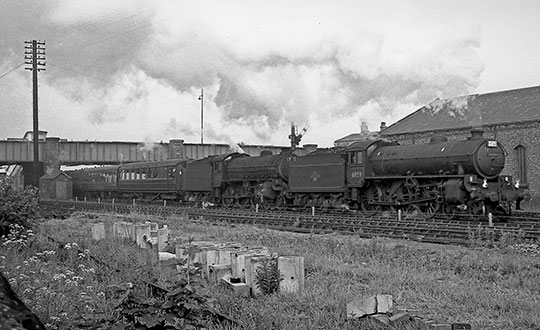
Photo: Roger Hepworth
As the coaches snaked over the obvious hump of the road bridge at the summit of the bank the engine drivers would shut off steam and drift down into the station. There would be a considerable number of waiting families who would now try to spot empty tables or compartments and then scramble aboard, complete with canvas shopping bags of sandwiches, thermoses and squash. Pushchairs and prams were loaded into the front brake end, which would be just on the platform end, their owners then walking down inside the train to find seats.
Because the island platform was on the outside of a long curve it needed the booking clerk to emerge from his office near the front of the train to check the door handles there and give the OK to the porter near the rear. These two worthies then relayed the ‘right away’ down the right hand side of the train to the engine crews. This was acknowledged first by the fireman of the train engine, who would shout across the footplate to his mate, and wave to his opposite number on the leading engine, standing in the smoky murk under the steel girders of the road overbridge. He in turn shouted ‘right away’ to his driver. Two slightly different-toned whistle pops rang out, two regulators opened, two snifting valves clunked and two crisp, unsynchronised exhausts roared into life. To a bystander on the public footpath which ran alongside the line beyond the station the display of power was awe-inspiring and even at this distance of time the memory sends a tingle down the spine. The steadily accelerating engines would somehow synchronise their exhausts as they enveloped themselves in steam from their chimneys and sometimes leaking front ends. The sound of the receding engines gave way to the rhythmic clicking of wheels on rail joints as the carriages glided past, themselves wreathed in steam which escaped from heating pipes and showed up bright white in the chill spring air.
Passengers settled into their seats and used their coat sleeves to wipe semi-circles into the mist on the insides of damp windows. Each coach carried neatly on its centre window a boldly printed foolscap-size poster detailing in large black capitals the originating station and, in smaller capitals, the calling places of the train. In those days, long before computerised departure screens, these paper labels were invaluable at home-time at the resort, when there could be half a dozen trains in the platforms awaiting departure. Weary families found it comforting to find the name of their home station displayed on the coach window.
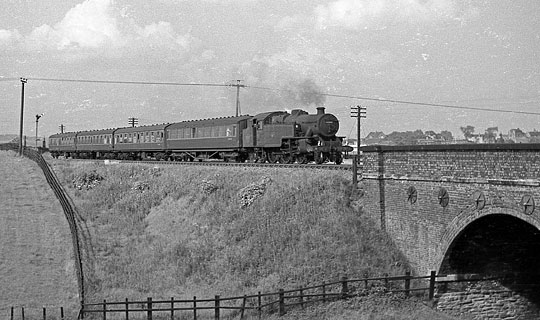
Photo: Roger Hepworth
However, back on our 1950s Easter Sunday, as birdsong starts to drown out the receding sound of our seaside excursion dropping down the gradient towards Wakefield, the next couple of hours holds the prospect of at least two more excursions. One might have only eight coaches, which was just within the capability of a single B1 if worked hard. Ten-coach trains were always piloted, usually by another B1, but sometimes an N1 tank or a J39 or J6 0-6-0. In the early 1960s ex-Calder Valley LMS engines began to appear. Crabs, Black 5s and 2-6-4 tanks became regular performers with occasional visits from K1s and Ivatt 2-6-0s. Later still L1s appeared – also Standard 2-6-4 Ts, Standard 5s and the odd 4F, K3 or Jubilee – the tank engines only used as pilots.
Following the Easter weekend there would be more excursions at Whitsuntide and the other local holiday period in August – Dewsbury Feast. In fact most summer Sundays saw at least one excursion including the annual one to ‘Peterborough and the Bulb Fields’, uniquely provided with a buffet car. There was also the unmissable ‘Yorkshire Coast by Tourist Train’, advertised in advance by a double-sized handbill, complete with pictures. This was a round trip via Pickering, Whitby and the coast line via Robin Hood’s Bay to Scarborough. Time was allowed at both Whitby and Scarborough before the return journey by the direct route through Kirkham Abbey. Four reversals were involved in this journey, the highlight of which consisted of being pulled backwards by a pilot engine on the rear of the train from Whitby Town to West Cliff Station – the train engine then being correctly positioned to continue the journey to Scarborough.
There was also the hugely-popular annual guaranteed excursion for the local Working Men’s Club which often loaded to thirteen coaches, including a BG in the centre for the dispensing of refreshments supplied on the day by the local mineral water manufacturers and off-licence owners Messrs Hanson & Bentley. This heavy train was always double-headed through to its seaside destination. It was such a train which on its return from Redcar formed the last service to call at Ossett Station at two o’clock in the morning on the first Sunday in September 1964, pulled by Jubilee ‘Bellerophon’, piloted by a B1. It was a previous excursion one Saturday in the early 1960s to the FA Cup Final at Wembley which brought the only main line diesel ever to call at Ossett station – an English Electric Type 4 piloted by a Black 5. Full journey descriptions of some of these trains will have to be another story – suffice it to say that for the rest of our Easter Sunday our branch line would settle down to slumber until about 8.00pm, when station and signal box lights would be switched on ready to welcome back the returning excursionists. In the case of some late night return arrivals a special bus would meet the train at Castleford. Travellers would be conveyed back to their homes in the outlying districts by a green West Riding rear-entrance double decker, the normal last buses having already gone.
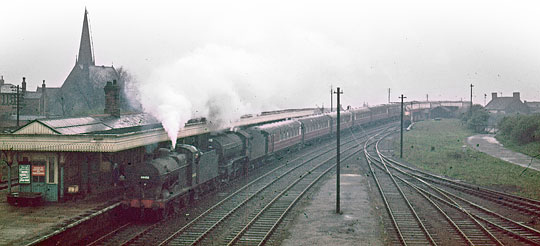
Photo: Roger Hepworth
In few very short years the day trip market would be taken over by the ‘charabanc’ – huge numbers of these arriving in the extensive coach parks at, for example, Bridlington or Blackpool, on land converted ironically from railway carriage sidings. Then came the private car and soon, with increasing fuel prices, the decline of the seaside trip altogether. However back in the 1950s what a wealth of travel opportunities was offered by excursion trains to a public whose daily lives involved the railway and took it for granted in a fashion which is quite unknown today.





